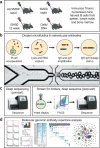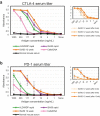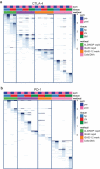Antibody repertoire analysis of mouse immunization protocols using microfluidics and molecular genomics
- PMID: 30898066
- PMCID: PMC6601537
- DOI: 10.1080/19420862.2019.1583995
Antibody repertoire analysis of mouse immunization protocols using microfluidics and molecular genomics
Abstract
Immunization of mice followed by hybridoma or B-cell screening is one of the most common antibody discovery methods used to generate therapeutic monoclonal antibody (mAb) candidates. There are a multitude of different immunization protocols that can generate an immune response in animals. However, an extensive analysis of the antibody repertoires that these alternative immunization protocols can generate has not been performed. In this study, we immunized mice that transgenically express human antibodies with either programmed cell death 1 protein or cytotoxic T-lymphocyte associated protein 4 using four different immunization protocols, and then utilized a single cell microfluidic platform to generate tissue-specific, natively paired immunoglobulin (Ig) repertoires from each method and enriched for target-specific binders using yeast single-chain variable fragment (scFv) display. We deep sequenced the scFv repertoires from both the pre-sort and post-sort libraries. All methods and both targets yielded similar oligoclonality, variable (V) and joining (J) gene usage, and divergence from germline of enriched libraries. However, there were differences between targets and/or immunization protocols for overall clonal counts, complementarity-determining region 3 (CDR3) length, and antibody/CDR3 sequence diversity. Our data suggest that, although different immunization protocols may generate a response to an antigen, performing multiple immunization protocols in parallel can yield greater Ig diversity. We conclude that modern microfluidic methods, followed by an extensive molecular genomic analysis of antibody repertoires, can be used to quickly analyze new immunization protocols or mouse platforms.
Keywords: CTLA-4; Humanized mouse antibody repertoires; PD-1; adjuvants; deep sequencing; mouse immunization; yeast display.
Figures







Similar articles
-
Rare, high-affinity mouse anti-PD-1 antibodies that function in checkpoint blockade, discovered using microfluidics and molecular genomics.MAbs. 2017 Nov/Dec;9(8):1270-1281. doi: 10.1080/19420862.2017.1371386. Epub 2017 Aug 28. MAbs. 2017. PMID: 28846506 Free PMC article.
-
Rare, high-affinity anti-pathogen antibodies from human repertoires, discovered using microfluidics and molecular genomics.MAbs. 2017 Nov/Dec;9(8):1282-1296. doi: 10.1080/19420862.2017.1371383. Epub 2017 Aug 28. MAbs. 2017. PMID: 28846502 Free PMC article.
-
A natively paired antibody library yields drug leads with higher sensitivity and specificity than a randomly paired antibody library.MAbs. 2018 Apr;10(3):431-443. doi: 10.1080/19420862.2018.1426422. Epub 2018 Feb 1. MAbs. 2018. PMID: 29376776 Free PMC article.
-
Primer Design and Inverse PCR on Yeast Display Antibody Selection Outputs.Methods Mol Biol. 2018;1721:35-45. doi: 10.1007/978-1-4939-7546-4_4. Methods Mol Biol. 2018. PMID: 29423845 Review.
-
The role of phage display in therapeutic antibody discovery.Int Immunol. 2014 Dec;26(12):649-57. doi: 10.1093/intimm/dxu082. Epub 2014 Aug 18. Int Immunol. 2014. PMID: 25135889 Free PMC article. Review.
Cited by
-
Immunizations with diverse sarbecovirus receptor-binding domains elicit SARS-CoV-2 neutralizing antibodies against a conserved site of vulnerability.Immunity. 2021 Dec 14;54(12):2908-2921.e6. doi: 10.1016/j.immuni.2021.10.019. Epub 2021 Oct 29. Immunity. 2021. PMID: 34788600 Free PMC article.
-
High-throughput analysis system of interaction kinetics for data-driven antibody design.Sci Rep. 2023 Nov 21;13(1):19417. doi: 10.1038/s41598-023-46756-y. Sci Rep. 2023. PMID: 37990030 Free PMC article.
-
Generation of a single-cell B cell atlas of antibody repertoires and transcriptomes to identify signatures associated with antigen specificity.iScience. 2023 Jan 25;26(3):106055. doi: 10.1016/j.isci.2023.106055. eCollection 2023 Mar 17. iScience. 2023. PMID: 36852274 Free PMC article.
-
Efficient human-like antibody repertoire and hybridoma production in trans-chromosomic mice carrying megabase-sized human immunoglobulin loci.Nat Commun. 2022 Apr 5;13(1):1841. doi: 10.1038/s41467-022-29421-2. Nat Commun. 2022. PMID: 35383174 Free PMC article.
-
Versatile and rapid microfluidics-assisted antibody discovery.MAbs. 2021 Jan-Dec;13(1):1978130. doi: 10.1080/19420862.2021.1978130. MAbs. 2021. PMID: 34586015 Free PMC article.
References
Publication types
MeSH terms
Substances
Grants and funding
LinkOut - more resources
Full Text Sources
Other Literature Sources
Medical
